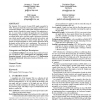Free Online Productivity Tools
i2Speak
i2Symbol
i2OCR
iTex2Img
iWeb2Print
iWeb2Shot
i2Type
iPdf2Split
iPdf2Merge
i2Bopomofo
i2Arabic
i2Style
i2Image
i2PDF
iLatex2Rtf
Sci2ools
WWW
2005
ACM
2005
ACM
Named graphs, provenance and trust
The Semantic Web consists of many RDF graphs nameable by URIs. This paper extends the syntax and semantics of RDF to cover such Named Graphs. This enables RDF statements that describe graphs, which is beneficial in many Semantic Web application areas. As a case study, we explore the application area of Semantic Web publishing: Named Graphs allow publishers to communicate assertional intent, and to sign their graphs; information consumers can evaluate specific graphs using task-specific trust policies, and act on information from those Named Graphs that they accept. Graphs are trusted depending on: their content; information about the graph; and the task the user is performing. The extension of RDF to Named Graphs provides a formally defined framework to be a foundation for the Semantic Web trust layer. Categories and Subject Descriptors I.2.4 [Artificial Intelligence]: Knowledge Representation Formalisms and Methods; K.6.5 [Management of Computing and Information Systems]: Security an...
| Added | 22 Nov 2009 |
| Updated | 22 Nov 2009 |
| Type | Conference |
| Year | 2005 |
| Where | WWW |
| Authors | Jeremy J. Carroll, Christian Bizer, Patrick J. Hayes, Patrick Stickler |
Comments (0)

